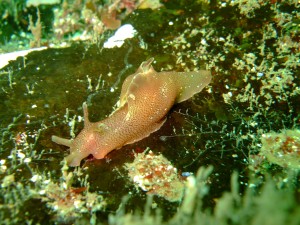 Here are some facts about this months species - the sea hare.
Here are some facts about this months species - the sea hare.
Did you know?
- Sea hares are a small slug like invertebrates with two long slender tentacles (rhinophores) on their head which are used as their main sensory organs. These are said to resemble the ears of a hare giving the animals their name.
- They have bulky, fleshy bodies with wing like lobes on either side.
- Sea hares are gastropods. This means they are related to snails and so have a shell. In sea hares the shell is internal.
- Adult sea hares in the UK are usually 4 or 5 cm but can grow to up to 20 cm!
- They are closely related to the largest gastropod in the world, the California sea hare that can grow to up to 41cm.
- Sea hares can be red, brown, dark purple, olive or green and their colour depends upon the pigments in the sea weed they are grazing on. This means that they are well camouflaged and spotting them can be difficult!
- Many species of gastropod found in the UK can be described as “sea hares”. The main species found on the South East coast of Scotland is Aplysia punctata. These can be spotted by both divers and rock poolers and are very well camouflaged.
Rockpools
- Sea hares are particularly common in rockpools during the spring months when they migrate to the shore to breed.
- Adults found in rockpools during the mating season are usually green, olive or brown as they have been feeding on the brown algae found on the rocky shore.
- It is thought that A. punctata migrate towards the coast by gliding across the sea floor but some species can do so by swimming using the wing like lobes on the sides of their body.
- Sea hares are hermaphrodites and chains of 10 or more mating sea hares can be found in rockpools during the breeding season. Recently school groups have found chains of mating sea hares in the rockpools around St Abbs.
- They lay orange-pink egg masses which can be found among the seaweed and each contain thousands of eggs.
- Once the eggs hatch after 2 or 3 weeks small larvae emerge and float in the water column before changing into young adults which sit on the sea floor.
In deeper water
- Sea hares spotted further out to sea by divers are usually juveniles and because they are found in different habitats their diet is usually different. This means that juveniles are usually red or purple in colour. This is not always the case and olive green sea hares can still be found grazing on the kelp forests around the reserve.
- Sea hares protect themselves by producing purple and white secretions when disturbed by fish and other predators. Very little is known about these secretions but they are not thought to be poisonous and instead are thought to be a technique used to distract the predator.




